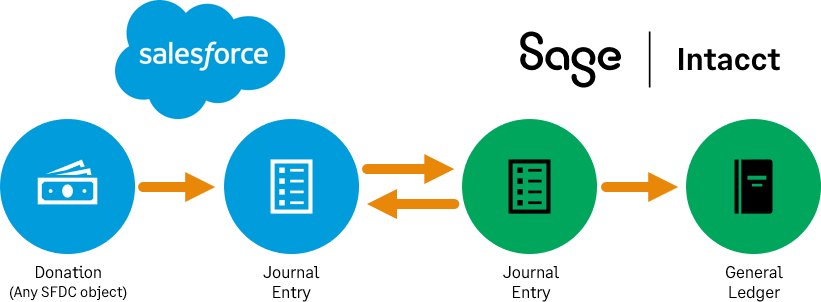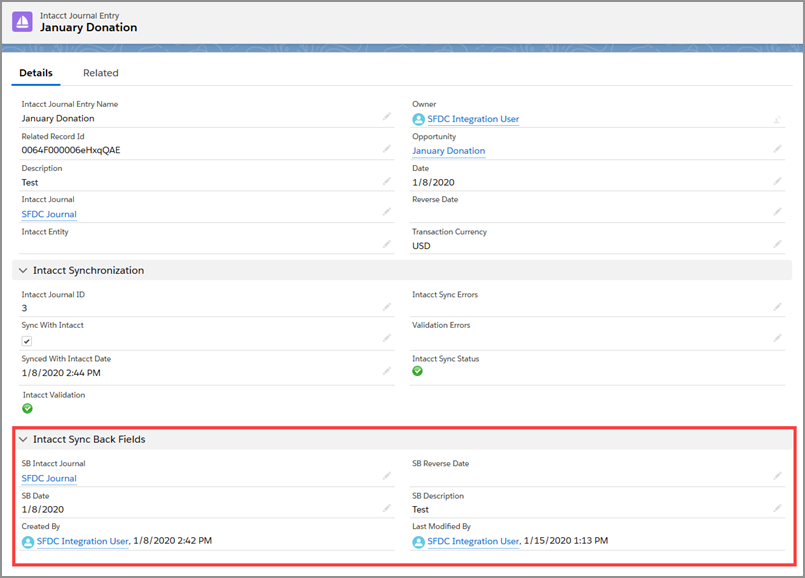Advanced CRM Integration for Nonprofits overview
Sage Intacct has expanded the capabilities of the Advanced CRM Integration to support nonprofit organizations. You can now choose where to leverage the Intacct AR subledger and Order Entry workflows. You can use these workflows for things like sponsorships or major gifts, and where to aggregate data transaction flows, such as for daily donations.
Nonprofits can use our flexible workflows to:
- Keep the front office and back office in sync.
- Improve collaboration
- Streamline reconciliation
- Use Sage Intacct Reporting and Dashboards for visibility.
- Streamline integration with new levels of real-time visibility across systems.
Integration with the Salesforce Nonprofit Cloud
The Advanced CRM Integration for Nonprofits works with the Salesforce Nonprofit Cloud. This new product from Salesforce streamlines operations for nonprofits, replacing the previously used Nonprofit Success Pack.
Synced objects
New objects now sync with Salesforce to support the Advanced CRM Integration for Nonprofits.
| Intacct Object | Sync Direction | Salesforce Object |
|---|---|---|
|
General Ledger Accounts |
To Salesforce |
Intacct Account |
|
Journals |
To Salesforce |
Intacct Journal |
|
User-defined dimensions |
To Salesforce |
Intacct User-defined dimensions |
|
Journal Entries |
Inserts: To Intacct Updates: From Intacct |
Intacct Journal Entries |
|
Journal Entry Lines |
Inserts: To Intacct Updates: From Intacct |
Intacct Journal Entry Lines |
Journal entries

The Advanced CRM General Ledger application and journal entry sync behave differently than other areas of the integration. For example:
- Journal entry transactions are first created within Salesforce, then the records are synced with Intacct.
- Changes and updates in Intacct do sync back to the original Salesforce journal entry. The Intacct journal entry has sync-back fields, so there’s a record of both the original entry and any changed transactions in Salesforce.
These differences allow you to use any object in Salesforce as the source for transaction information for journal entries. Using any object as the source means you can group Salesforce transactions into an Intacct journal entry, and schedule and automate journal entry creation and synchronization.
Journal entry and journal entry line objects
The Intacct journal entry and journal entry line objects are included in the Advanced CRM package. These two objects integrate with the Intacct General Ledger journals of your choice.
Advanced CRM automates the creation of the Intacct journal entry and journal entry lines in Salesforce, so you never need to create manually a journal entry record.

What makes Intacct journal entry and journal entry line records in Salesforce unique are the Intacct sync back fields. Sync back fields represent what's currently stored in Intacct. These fields contain the information Salesforce gets from the sync process, and any changes that are made in Intacct on the journal entry record.
For example, Salesforce syncs the School Fundraiser in the Description field. If this value is changed to Church Fundraiser in Intacct, the change is synced back to the Description field on the Salesforce journal entry.
Journal and journal entry mapping
Intacct journal entries can use any object in Salesforce as the journal entry header and journal entry line source. You create object and field mappings in Salesforce between the objects of your choice and the Intacct journal entry object in Salesforce.
You can create multiple sets of journal and journal entry mappings, which allows you to create journal entries from multiple Salesforce objects. This flexibility supports many different transaction workflows. You can also use journal entry mappings to group many source transactions into a single Intacct journal entry.
Dimension Default group
Another key feature of the journal entry creation process is the ability to automate dimension defaults on the Intacct journal entry. Automating dimension defaults is done using the Dimension Default Group. In Salesforce, the Intacct Dimension Default Group provides default values for Intacct dimensions on the Intacct journal entry.
A Dimension Default Group record is created to categorize and track specific details for the funds received for each type of donation, endowment, or grant. The categorization and tracking uses the capabilities of Intacct dimensional reporting.
Dimension Default Groups are assigned to specific journal and journal entry mappings, and are applied at the time the journal entry is created in Salesforce.

Allocation Default Group
Allocation Default Groups can be assigned to Dimension Default Groups. Allocation Default Groups provide you with another level of distributing funds across different accounts and dimensions using a percentage-based method.
Synchronization automation
To create a journal entry in Intacct, there are two things that first must happen:
- Generate the Intacct Journal Entry Transaction for Salesforce source records.
- Synchronize the Intacct Journal Entry from Salesforce to Intacct.
These processes can be triggered manually or via process builder workflows. The Advanced CRM Integration also provides scheduling capabilities to automate these steps.

Requirements
The Advanced CRM Integration for Nonprofits has no special requirements for installation and use other than the basic Advanced CRM Integration requirements.
In this topic
